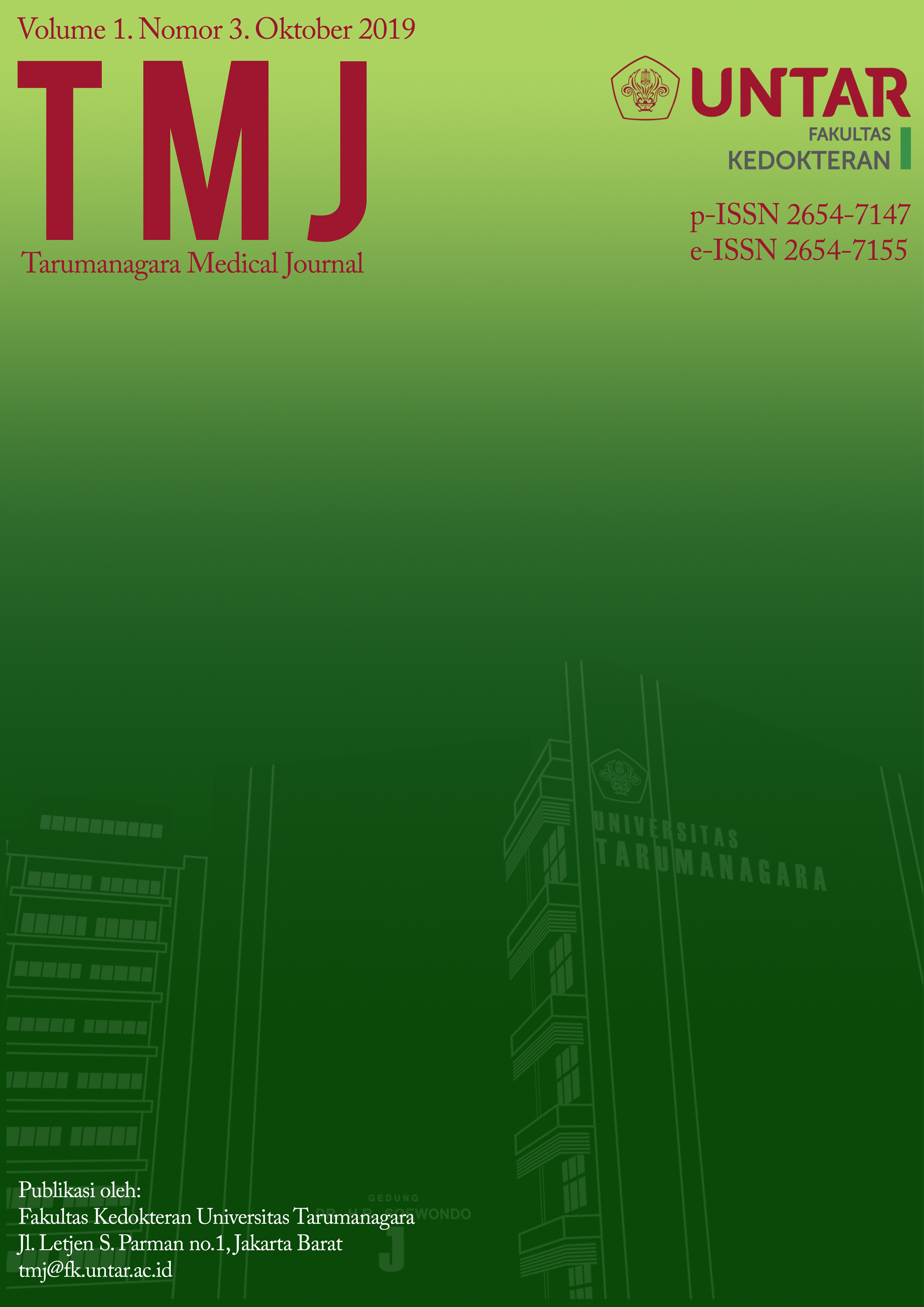Hubungan faktor genetika terhadap kejadian astigmatisma pada mahasiswa Fakultas Kedokteran Universitas Tarumanagara Angkatan 2013
Main Article Content
Abstract
Article Details

This work is licensed under a Creative Commons Attribution-NonCommercial-ShareAlike 4.0 International License.
Penulis yang menerbitkan artikelnya di Tarumanagara Medical Journal (TMJ) setuju dengan ketentuan sebagai berikut:
- Penulis mempertahankan hak cipta dan memberikan jurnal hak publikasi pertama dengan bekerja secara bersamaan dilisensikan di bawah Creative Commons Attribution yang memungkinkan orang lain untuk berbagi karya dengan pengakuan atas kepengarangan dari karya asli dan publikasi dalam jurnal ini.
- Penulis dapat masuk ke dalam pengaturan kontrak tambahan yang terpisah untuk distribusi non-eksklusif jurnal versi pekerjaan yang dipublikasikan (misalnya, memposting ke repositori institusional atau menerbitkannya dalam buku), dengan pengakuan publikasi awal dalam jurnal ini.
- Setiap teks yang dikirim harus disertai dengan "Perjanjian Transfer Hak Cipta" yang dapat diunduh melalui tautan berikut: Unduh
References
World Health Organization. Global magnitude of visual impairment caused by uncorrected refractive errors in 2004. (updated 2008 Feb; cited 2015 Jul 24). Available from: http://www.who.int/bulletin/volumes/86/1/07-041210/en/
World Health Organization. What is a refractive error? (updated 2013 Oct 7; cited 2015 Jul 24). Available from: http://www.who.int/features/qa/45/en/
World Health Organization. Blindness avoided for millions of children. 2015 (cited 2015 Jul 24). Available from: http://www.who.int/features/2009/preventing_blindness/photo_story/en/
Wolffsohn JS, Bhogal S, Shah S. Effect of uncorrected astigmatism on vision. J Cataract Refract Surg. 2011 (cited 2015 Jul 24); 37(3):454-60. Available from: http://www.ncbi.nlm.nih.gov/pubmed/21333869
World Health Organization. Visual impairment and blindness. (updated 2014 Aug; cited 2015 Jul 24). Available from: http://www.who.int/mediacentre/factsheets/fs282/en/
American Optometric Association. Computer vision syndrome. 2015 (cited 2015 Jul 24). Available from: https://www.aoa.org/ patients-and-public/caring-for-your-vision/ protecting-your-vision/computer-vision-syndrome
Rosenfield M, Hue JE, Huang RR, Bababekova Y. The effects of induced oblique astigmatism on symptoms and reading performance while viewing a computer screen. Opthalmic Physiol Opt. 2012 Mar (cited 2015 Jul 24);32(2):142-8. Available from: https://onlinelibrary.wiley.com/doi /abs/10.1111/j.1475-1313.2011.00887.x
Wen G, Hornoch KT, Codwin RM, Cotter SA, Borchert M, Lin J, et al. Prevalence of myopia, hypermiopia, and astigmatism in non hispanic white and asian children: multi-ethnic pediatric eye disease study. Department of Preventive Medicine, Keck School of Medicine, University of Southern California, Los Angeles, CA. 2013 Okt (cited 2015 Jul 24); 120(10): 2109– 2116. Available from: h https://www.ncbi.nlm.nih.gov/pmc/articles/PMC3902090/
Hashemi H, Rezvan F, Yekta AA, Hasemi M, Norouzirad R, Khabazkhoob M. The Prevalence of Astigmatism and its Determinants in a Rural Population of Iran: The “Nooravaran Salamat” Mobile Eye Clinic Experience. Middle East Afr J Ophthalmol. 2014 Apr-Jun (cited 2015 Jul 25); 21(2): 175–181. Available from: http://www.ncbi.nlm. nih.gov/pmc/articles/PMC4005184/
Read SA, Collins MJ, Carney LG. A review of astigmatism and its possible genesis. Clin Exp Optom. 2007 (cited 2015 Jul 26); 90: 1: 5-19. Available from: http://www.ncbi.nlm.nih. gov/pubmed/17177660
Ibironke JO, Friedman DS, Repka MX, Katz J, Giordano L, Hawse P, Tielsch JM. Child Development and Refractive Errors in Preschool Children. Optom Vis Sci. 2011 Feb (cited 2015 Jul 29); 88(2): 181–187. Available form: https://www.ncbi.nlm.nih.gov/pmc/ articles/PMC3079532/
Githeko K. Astigmatism after sutureless cataract surgery. Community Eye Health. 2004 (cited 2015 Jul 26); 17(49): 14. Available from: http://www.ncbi.nlm.nih.gov/ pmc/articles/PMC1705706/
Gregori D, Cortassa F, Catena F, Marra A. Heritability of corneal curvature and astigmatism: a videokeratographic child-parent comparison study. Cornea. 2007 Sep (cited 2015 Jul 30);26(8):907-12. Available from: https://www.ncbi.nlm.nih.gov/pubmed/ 17721286.
Medscape. Lasik Astigmatism. (updated Mar 27, 2014; cited 2015 Aug 8). Available from: http://emedicine.medscape.com/article/1220489-overview#showall
Lopes MC, Hysi PG, Verhoeven VJM, et al. Identification of a Candidate Gene for Astigmatism. Investigative Ophthalmology & Visual Science February 2013 (cited 2015 Jul 28), Vol.54, 1260-1267. Available from: http://iovs.arvojournals.org/article.aspx?articleid=2127905



